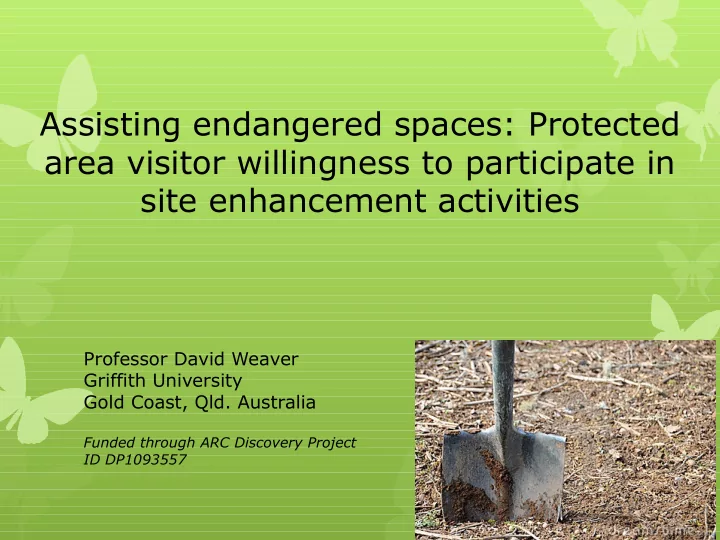

Assisting endangered spaces: Protected area visitor willingness to participate in site enhancement activities Professor David Weaver Griffith University Gold Coast, Qld. Australia Funded through ARC Discovery Project ID DP1093557
The contemporary protected area dilemma: Funding cutbacks and budgetary shortfalls from government sources = increasing reliance on visitor-based revenue But visitation may not be compatible with the environmental mandate of such entities
Park/visitor relationships: Three models (Budowski) Conflict : negative ecological impacts dominate Coexistence : neutral impact, e.g. ‘Leave no Trace’ Symbiosis : mutual reinforcement of visitor satisfaction and ecological integrity
Search for symbiosis has been elusive Conservation mandate as priority of managers; • tourists are a ‘necessary evil’ Fears of litigation and poor quality work • How willing are protected area visitors to participate in activities that enhance those parks, thus contributing to their ‘development’? What variables correlate with this willingness? Important to engage not just the ‘hard ecotourists’, but also the much more numerous ‘soft ecotourists’
Research framework Hard ecotourists enhancement sustainability (symbiosis) Soft ecotourists status quo sustainability (coexistence)
Lamington & Springbrook National Parks Endangered rainforest habitat • World Heritage listed • Exurban pressure • High visitation (600,000/yr) • Dual mandate for • preservation and ‘compatible recreation’ No entry fees •
Lamington & Springbrook National Parks
The Gold Coast (45 minutes drive)
Questionnaire distribution to visitors (Australians only) exiting park at major trailheads (Binna Burra & Purlingbrook Falls) August 2010 – March 2012; mail-in return 804 valid responses (33.9%) Sample representative of park visitor profiles
Principle components analysis of hypothetical activities: ‘Focused activism’ (13) ( in situ & ex situ ) Plant native vegetation • Help with scientific research • Fundraise • Help maintain trails, etc. • ‘Incidental activism’ (4) Pick up litter during walks • Report suspicious activity, etc. • ‘Monetary commitment’ (3) Pay entry fee • Make donations • Make bequest •
Six-cluster solution: 1. The ‘enthused’ (8.2%) Very positive on focused and incidental, weakly • positive on monetary Very positive biocentric & altruistic values • Regional (esp. Gold Coast) • High site loyalty (behavioural & attitudinal) • “If you organise any programs to help Lamington I will be happy to participate.” Gold Coast female, 35
Six-cluster solution: 2. The ‘incidentally enthused’ (12.3%) Ambivalent on focused, positive on incidental, • weakly positive on monetary Positive biocentric & altruistic values • Regional residents (esp. Brisbane) • High site loyalty • “happy to pay entry fees, happy to support government initiatives, probably would donate.” Out-of region female, 61
Six-cluster solution: 3. The ‘amenables’ (24.8%) Ambivalent on focused, weakly positive on • incidental, & negative on monetary Weakly positive biocentric & altruistic values • Regional residents (GC & Brisbane) • High WOM & intention-to-return site loyalty • Knowledge & skill concerns: “it is easy to report [suspicious activity] to the ranger; other tasks are difficult due to lack of my knowledge” Gold Coast female, 47 Expectations of government: “it [volunteering & donating] would only be worthwhile if Qld government is committed to the park” Brisbane female, 52
Six-cluster solution: 4. The ‘casually engaged’ (12.1%) Negative on focused, weakly positive on • incidental, & ambivalent on monetary (but willing to pay entry fee) Weakly positive biocentric & altruistic values • Regional residents • High WOM & intention-to-return site loyalty • “Why doesn’t the Queensland government charge a permit fee like NSW or Tasmania to raise adequate revenue for the park?” Brisbane female, 47
Six-cluster solution: 5. The ‘incidentals’ (26.1%) Very negative on focused, weakly positive on • incidental & monetary Weakly positive biocentric values & ambivalent • altruism regional, older • High WOM & intention-to-return site loyalty • “Volunteers should not be a substitute for well trained, suitably remunerated staff” Brisbane male, 55
Six-cluster solution: 6. The ‘disengaged’ (16.5%) Very negative on focused, ambivalent on • incidental, & very negative on monetary Weakly positive biocentric values & ambivalent • altruism Highest non-regional, older • High WOM & intention-to-return site loyalty • “I contribute a significant amount to tax. I do not feel it necessary to ‘help’ Springbrook National Park” Gold Coast male, 46
‘Supportive’ ≈20% Clusters Enthused Incidentally enthused Factors 1. Focused VP-P P-A activism 4.24 3.41 2. Incidental VP VP-P activism 4.74 4.27 3. Monetary P-A P-A commitments 3.40 3.41 Value = averaged sum of means for all factor items (range = 1-5)
‘Supportive’ ‘Ambivalent’ ≈20% ≈37% Clusters Enthused Incidentally Amenables Casually engaged enthused Factors 1. Focused VP-P P-A A N activism 4.24 3.41 2.81 2.36 2. Incidental VP VP-P P P activism 4.74 4.27 3.90 4.13 3. Monetary P-A P-A A-N A commitments 3.40 3.41 2.60 3.08
‘Supportive’ ‘Ambivalent’ ‘Non-supportive’ ≈20% ≈37% ≈43% Clusters Enthused Incidentally Amenables Casually Incidentals Disengaged Factors enthused engaged 1. Focused VP-P P-A A N N-VN VN activism 4.24 3.41 2.81 2.36 1.74 1.18 2. Incidental VP VP-P P P P-A A-N activism 4.74 4.27 3.90 4.13 3.70 2.47 3. Monetary P-A P-A A-N A N N-VN commitments 3.40 3.41 2.60 3.08 2.30 1.62
Analysis Latent core (≈10-15%) to seed enhancement • initiatives (i.e. the ‘hard ecotourists’) Values: altruism more strongly associated with • willingness than biocentrism
Analysis Opportunities beyond the core (‘soft ecotourists’): Incidental activities = ‘salient of opportunity’ • Most visitors: high visit satisfaction as well as • WOM & repeat visit intention, & biocentric leanings Interpretation to facilitate transformational • learning Assurance of government involvement • Address concerns about appropriate skills •
Analysis Role of age: average = 50, unsupportive are 54, • supportive are 48 “There is an urgent need for renewal of volunteer organisations affiliated with the park – we are mostly grey beards.” Brisbane male, 63 but “…just getting used to retirement and what I will do” Brisbane female, 64
Aspiration: Results used to inform the creation of the world’s • first ecotourium, or existing protected area where visitor engagement in activism is a major focus of planning and management “Visitors as opportunity, not threat…”
Recommend
More recommend